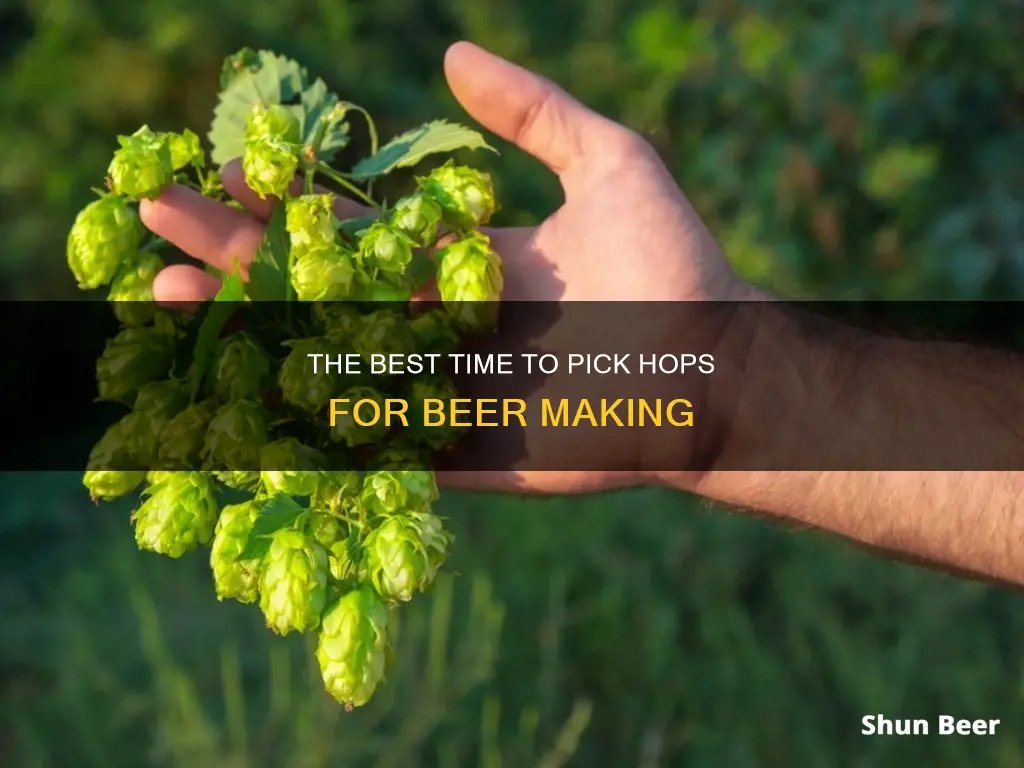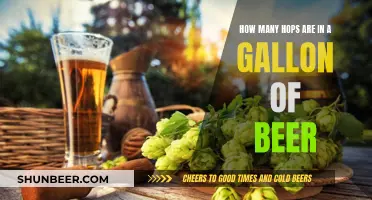
Hops are usually ready to be picked for beer-making between mid-August and September, depending on your location. The hops plant is a long, climbing vine, and the hops themselves are the female flower cones of the plant. When ripe, they will feel light and dry, and will spring back after a squeeze. They should also smell pungent, like a mix of grass, pine, citrus and onion. If you're growing hops for home consumption, there's a relatively long window for picking, and you don't need to worry about maximising yields.
| Characteristics | Values |
|---|---|
| Time of year | Late August to mid-September |
| Cone colour | Fading from bright green to yellow-green with some browning around the edges |
| Cone texture | Dry, papery, light and springy |
| Cone behaviour | Breaks like a carrot |
| Cone sap | Sticky |
| Cone smell | Pungent, like a mix of grass, pine, citrus and onion |
| Cone sound | Makes a cricket sound |
| Lupulin colour | Yellow |
| Lupulin smell | Rancid if overripe |
What You'll Learn
- Hops are usually ready to pick between late August and September
- Check if the cones are sticky and spring back after a squeeze
- Cones should be light and dry, not damp and squishy
- The hops will have a strong, pungent smell when ready
- If the lupulin is orange and smells rancid, the hops are past their prime

Hops are usually ready to pick between late August and September
To determine if your hops are ready for harvest, there are several signs to look for. Firstly, the cones will begin to change colour from a vibrant, fresh green to a lighter yellow-green, and you may notice some browning around the edges. The texture of the cones is another indicator; ripe cones will feel dry and papery, while unripe cones will feel damp and soft. When you squeeze a ripe cone, it should spring back to its original shape, whereas an unripe cone will stay compressed.
Another way to test the ripeness of hops is to break a cone in half. If it breaks cleanly like a carrot, it is ready for harvest. Ripe cones will also have a strong, pungent aroma reminiscent of grass, pine, citrus, and onion. Additionally, the presence of yellow lupulin, a sticky powder inside the cone, indicates that the hops are ready for picking.
It is important to note that overripe hops are preferable to underripe hops. If you are unsure, it is better to wait a little longer before harvesting.
Once you have determined that your hops are ready, you can start picking them by hand or cutting down the entire vine, depending on its height and accessibility. After harvesting, the hops need to be dried and stored properly to preserve their flavour and freshness.
Hopping Techniques for the Perfect NEIPA Brew
You may want to see also

Check if the cones are sticky and spring back after a squeeze
When it comes to picking hops for beer-making, timing is crucial. Picking too early can result in missing out on the pungent, bitter flavours that come with riper hops. So, how can you tell when your hops are ready for harvesting?
One key indicator is the texture of the hop cones. Give a cone a gentle squeeze – if it stays compressed, it's not ready yet. Ripe cones will feel light and dry, and will spring back after a gentle squeeze. They will also start to feel papery, and when you rub them between your fingers, your fingers will feel sticky and oily. This stickiness is caused by the release of a yellow, sticky powder, which is a sign that your hops are ready for harvest.
In addition to the texture test, you can also check the colour of the cones. As hops ripen, they will lose their vibrant green colour and start to show some browning around the edges. This is a sign that they are reaching maturity.
It's important to remember that not all cones on the same plant will ripen at the same time, so be sure to check multiple cones before harvesting. The harvesting season for hops is typically between mid-August and September, depending on your location.
By using these indicators, you can ensure that you are picking your hops at the optimal time for brewing.
Dry Hopping Beer: Contamination Risk or Myth?
You may want to see also

Cones should be light and dry, not damp and squishy
When it comes to picking hops for beer-making, timing is crucial. Depending on your location, the hops are usually ready to harvest between mid-August and September. However, it's important not to pick the hops too early, as this can deprive them of valuable alpha acids that contribute to the flavour and quality of the beer.
To determine if your hops are ready for picking, it's essential to examine the cones closely. Give a cone a light squeeze; if it stays compressed, it's not quite ripe yet. On the other hand, if it feels light and dry and quickly springs back to its original shape after squeezing, it's ready for harvesting. This dryness and springiness are important indicators that the cones are mature and have reached their optimal stage for beer-making.
Another way to assess the cones' readiness is by smell. Pick a cone, roll it in your hands to release its aroma, and take a whiff. If it has a pungent, distinctive smell that reminds you of a combination of freshly cut grass and onion, it's an indication that the hops are ready to be picked. This unique aroma is a result of the cones' essential oils and compounds, which contribute to the flavour and character of the beer.
It's also worth noting that the cones should have a certain texture. The tips of the cones should feel dry and papery, and they should be slightly sticky to the touch. These textural cues are further indications that the hops are mature and ready for picking.
Once you've determined that the cones are ready, it's time to start harvesting. There are two methods for picking hops: by hand or by cutting down the bine. For first-year hops, it's recommended to pick the cones by hand, as it allows the vital nutrients to flow back to the root system, strengthening the plant for the upcoming winter months. In subsequent years, cutting down the bine is more efficient, but it's important to cut at least two to three feet above the ground to avoid damaging the root system and crown.
In summary, when picking hops for beer-making, it's crucial to pay attention to the cones' texture, aroma, and resilience. By ensuring they are light and dry, have a distinctive aroma, and spring back quickly after squeezing, you'll know they are ready to be harvested and will provide the best flavour and quality for your beer-making endeavours.
Crafting the Perfect Rolling Hop Beer: A Brewer's Guide
You may want to see also

The hops will have a strong, pungent smell when ready
Hops are usually ready to be picked in late August or early September, depending on your location. However, it's important to know exactly when to harvest them to get the best yield. One way to determine this is by observing the strong, pungent smell of the hops.
When ready, hops will have a strong, pungent aroma. This smell has been described as a mix of grass, pine, citrus, and onion. If you squeeze the hop cones and they release this strong, pungent odour, it's a good indication that they are ready to be harvested.
To identify this scent, pick a hop cone and roll it between your hands. Then, bring your hands close to your nose and take a deep sniff. If the aroma is predominantly green, grassy, or vegetal, the hops are not yet ready for harvest. However, if the smell of hoppy beer takes over, it's a sign that the hops are mature and ready for picking.
In addition to the strong smell, you can also look for other signs of readiness. The colour of the hops will change from a vibrant, fresh green to a lighter yellow-green as they mature. You may also start to notice some browning around the edges of the cones. When ripe, the hops will feel drier and more papery to the touch.
It's important to note that overripe hops are preferable to underripe hops. If you're unsure, it's better to wait a little longer before harvesting. Once you have identified the signs of overripe hops, it will be easier to recognise when the hops are ready for harvest in future years.
By paying attention to the strong, pungent smell and other indicators, you can ensure that you harvest your hops at the optimal time to get the best flavour and yield for your beer-making endeavours.
Hops-Free Brews: Exploring the World of Hopless Beers
You may want to see also

If the lupulin is orange and smells rancid, the hops are past their prime
When it comes to picking hops for beer-making, timing is crucial. Hops are typically harvested between mid-August and September, depending on the location and the plant's maturity. However, if you pick the hops too early, you may miss out on the desired pungent, bitter flavour. It is preferable to allow them to over-ripen on the bine than to harvest them too soon.
To determine whether your hops are ready for harvest, you can perform a few simple tests:
- Squeeze Test: Give the hop cone a light squeeze. If it stays compressed, it is not yet ripe. A ripe cone will feel light and dry, and it will spring back to its original shape after being squeezed.
- Smell Test: Pick a cone and roll it between your hands. If it emits a pungent aroma reminiscent of cut grass, onion, pine, or citrus, it is ready for harvest.
- Sound Test: Roll the hop cone next to your ear. If you hear a cricket-like sound, it indicates that the hop is ready for picking.
- Visual Inspection: Examine the hop cone for the presence of lupulin, a thick yellow substance found on the outside of the cone. If the lupulin has turned orange and gives off a rancid odour, it is a sign that you have missed the optimal harvest window.
If you notice that the lupulin is orange and smells rancid, it means that your hops are past their prime. This can happen if you wait too long to harvest them. The hops will be considered overripe, and the quality of the lupulin, which is crucial for imparting flavour and aroma in beer, will have deteriorated.
To avoid picking hops that are past their prime, it is essential to monitor the cones closely as the harvest period approaches. While it is better to allow them to over-ripen than to pick them too early, acting promptly once the hops reach their peak is crucial. The optimal harvest window can be narrow, and missing it can result in a loss of the desired alpha acids and the distinctive characteristics that make hops so valuable in beer-making.
Therefore, if you notice that the lupulin has turned orange and smells rancid, it is an indication that you need to harvest your hops earlier in the future. By observing the signs of ripeness and harvesting within the appropriate timeframe, you can ensure that you capture the hops at their most flavourful and aromatic stage, resulting in a higher-quality end product for your beer-making endeavours.
Fresh Hop Beer: What's the Deal?
You may want to see also
Frequently asked questions
The hops are usually ready to be picked by late August or early September, depending on your location. To check if they are ready, squeeze a cone gently. If it stays compressed, it is not ripe enough. When they feel light, dry, and spring back after a squeeze, they are ready to be harvested.
There are two ways to harvest hops: by hand or by cutting down the bine. For first-year hops, it is recommended to pick the cones by hand. For subsequent years, cut the bine down 2 to 3 feet above the ground to prevent injury to the root system and crown.
There are several methods to dry hops, including using a food dehydrator, a well-ventilated oven, or a hop-drying screen. The key is to dry them quickly without heating them too much. The ideal temperature is below 140°F (60°C).
Once your hops are dried, place them in a sealable bag, remove as much air as possible, and store them in the freezer until you are ready to use them. Hops can be stored in the freezer for up to a year.







